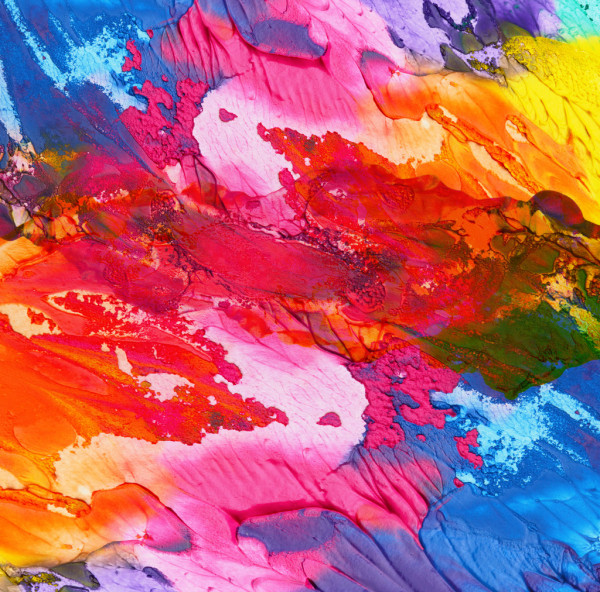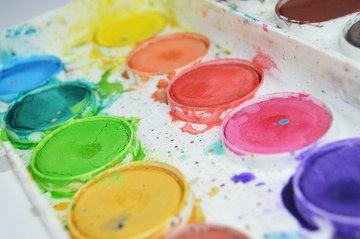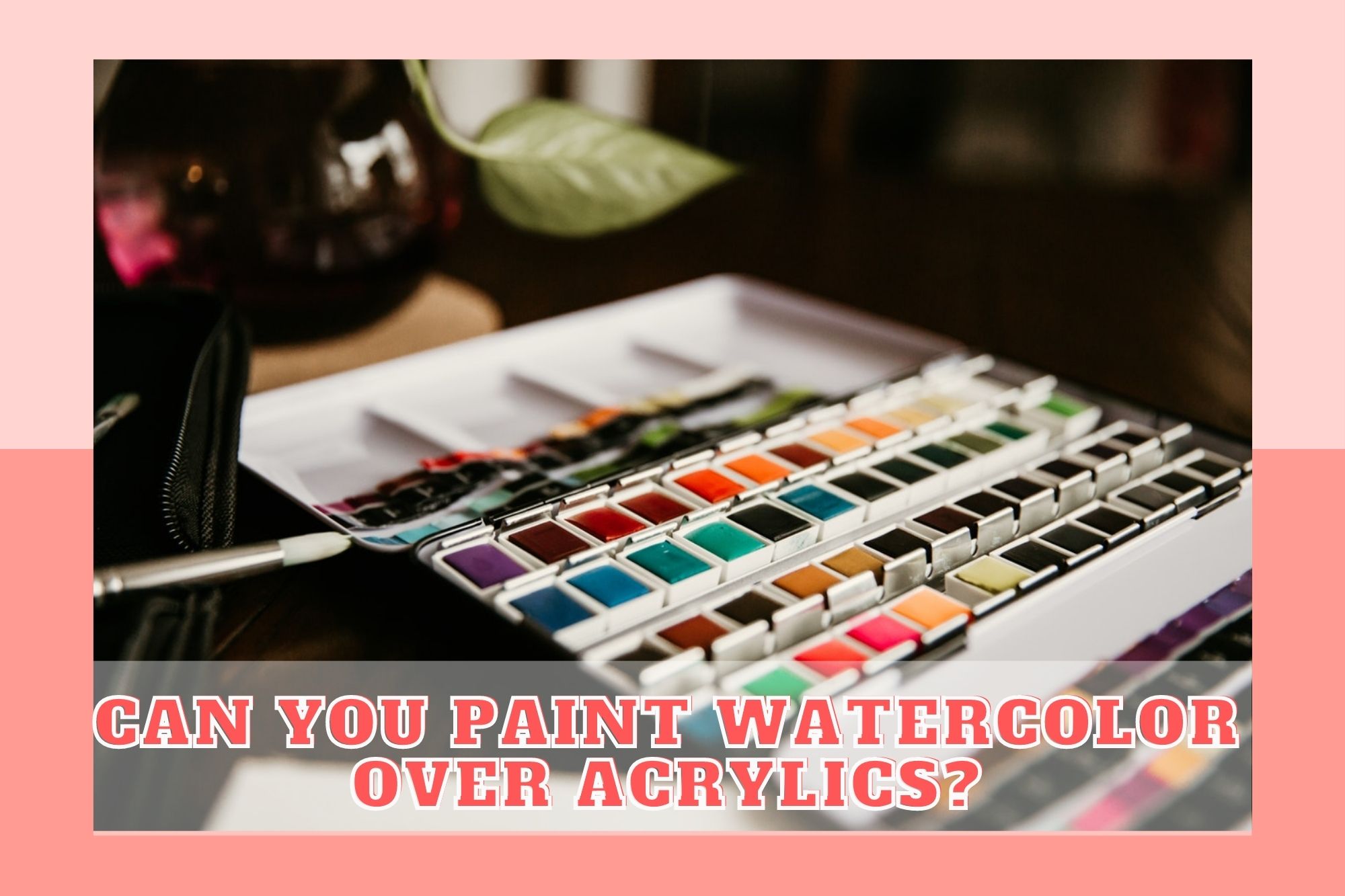Different and unique art techniques are being discovered nowadays.
Artists strive to discover novel and distinctive ideas to enhance the allure and distinctiveness of their paintings.
They constantly seek new painting methods, exploring various techniques to boost their happiness and creativity.
Can You Paint Watercolor Over Acrylics?
You can use watercolor over acrylics and vice versa. Separately, they can be used, and together they can be utilized depending upon the type of painting and effect desired to be created on your painting.
Today, watercolors and acrylics are two of the most favorite mediums of the artists and are used in almost all the paintings normally.
Mixing Watercolors With Acrylics
Because these two paint “cousins” are both water-based, you may mix and match them.

It’s important to remember that painting acrylic over watercolor paint works best because when you mix watercolor with acrylic paint, it thickens and becomes waterproof once it dries, which means your watercolor paint won’t stay.
It’s best to use heavyweight paper for this so that your work doesn’t get distorted after you’ve used these watery media.
To begin, paint a layer of watercolor on your paper. You can use a single, thick coat of paint, blend colors together, or make a translucent glaze by adding water. After that layer has dried fully, use the acrylic paint to sketch or paint over it.
Watercolors VS. Acrylics?
When offered the option of learning watercolor or acrylic painting, everyone prefers watercolor. In fact, when people ask professionals how to learn to paint, they have to give them an acrylic painting pep talk.
The reality is that most people are at ease with watercolor since it is so widely utilized. Its colors appeal to us because they are cheerful and bright.
Watercolor paintings may be found in greeting cards, labels, drawings, animations, and the list goes on and on.
When we think of acrylic painting, though, our mental process shifts. We think to ourselves, “Oh, I’m not an artist” or “That looks difficult.” “I’d never be able to achieve that.” Want to know a little secret? In fact, it’s the polar opposite!
Acrylic paint is forgiving and ideal for beginners. As a result, it’s an excellent medium to start with, while learning to paint. Because acrylic is opaque, it dries quickly and covers nicely.
You start with dark hues and work your way to lighter ones. The genuine color will shine through even the darkest hues when adding color over any dry section of your work.
Working with wet paint combines and mixes wonderfully on canvas without the need for pre-mixing on your palette.
Watercolor might be more difficult to work with. While painting with watercolor, you may build up layers of color, but you do so in a different order than with acrylic paint.
Watercolor is transparent, so you can’t hide your mistakes as you can with acrylic.
Watercolor is a time-consuming procedure. It’s a dance of figuring out how much water to use for each hue and then putting it on absorbent paper.
The key to success is timing, which comes with practice and a lot of painting. Working with watercolors can be done wet on wet or wet on dry.
Once you’ve figured out how much water to use, your painting will soar to new heights and you’ll be able to achieve true color.
I would suggest that you learn acrylic painting first, as well as some of the painting fundamentals that will aid you in studying watercolor. When it comes to painting, watercolor is the older, wiser sister of acrylic.
You might wish to take your painting outside as the spring and summer months approach. If that’s the case, watercolor is unquestionably the best medium for the job.
Watercolor is the most basic media, requiring only your travel set of colors, one complete brush with a very tiny tip, a nice 140lb bond watercolor paper, and a spray bottle of water.
If your watercolor paint dries while you’re painting outside, just dip your sable brush into water and rewet the paint or paper. Depending on the pigments you choose, you may even revive dried watercolor paint by adding water.
Painting with acrylics outside might be more difficult. Acrylic paint is a form of plastic that dries quickly in the sun and at high temperatures.Even before you reach the canvas, paint might dry on your brush.
Moreover, unlike watercolor, adding water does not result in the creation of more acrylic paint.
Does Watercolor Work With Acrylics?

As a general rule, acrylic can be painted over watercolor but not the other way around. The same is true for oil and acrylic; you may use acrylic as a basis and then paint oil on top, but not the other way around because the oil in the paint will separate the water molecules in the watercolor over time, causing the paint to fracture.
Watercolor requires a substrate that will absorb the water’s wetness. Polymer is what holds the pigment together in Acrylic (which is basically like plastic).
Whatever mixed media you use for your watercolor, be sure the layer underneath it can absorb water.
Can You Use The Same Brush For Acrylics And Watercolors?
If your watercolor brush is made of synthetic hairs, you can use acrylics with it; but, if your watercolor brush is made of natural hairs, don’t use acrylics with it.
Here are the reasons:
- Acrylic paint is rougher on a paintbrush than watercolors, thus natural hair paint brushes should be avoided.
- Due to the consistency of the paint and the more intensive cleaning required, using acrylics on natural hair brushes would simply hasten the mortality of the paintbrush.
- Because natural hair paint brushes may be rather expensive, it’s preferable to save them for watercolors exclusively.
Final Verdict
You can use watercolor over acrylics to give the watercolor effect in acrylic painting but you should not overuse it or use it carelessly because while this technique can give you an attractive painting, it can ruin your painting as well.
Good luck!
Beatrix Ainsley (Bea to her friends) is an abstract artist who was heavily inspired in her twenties by the abstract expressionist movement of the 1940s. Since then Bea has acquired three degrees in Science, Education and most importantly Fine Art. Her art works showcase exploring emotion and introspection of self. To achieve this – the use of bold, sweeping, intricate layers of color, and spontaneity of form is enhanced by reflecting on decades of life experiences. Bea has amassed a vast knowledge of art in all its forms, and hopes to pass it on with her contributions here.


